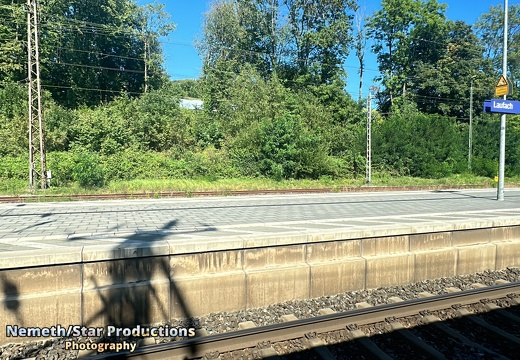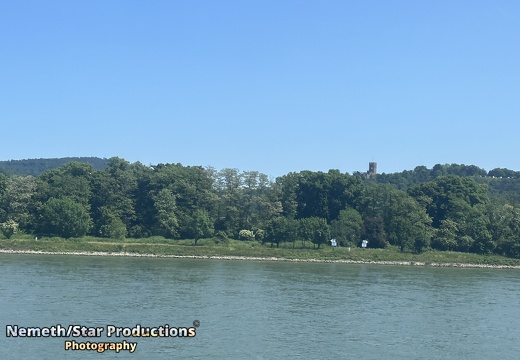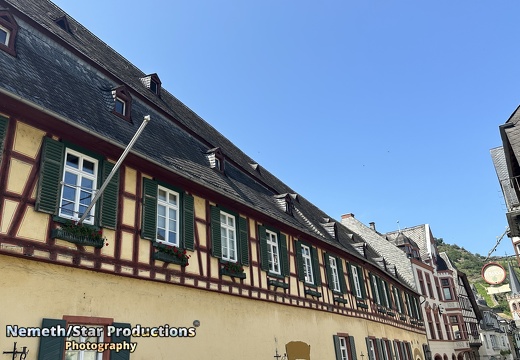
EP01 - Laufach
We return with a live posted episode of #RightNow for this shorter Season in 2023. Welcome to Laufach in Bavaria. The community lies in northwest Bavaria east of Aschaffenburg. Laufach lies in the heart of the Vorspessart (range) and stretches through its outlying centre of Hain into the High Spessart. The community’s elevation ranges from 170 to 500 m above sea level, including the peaks of Steigkoppe to the north and Steinknückl to the south. Laufach’s Ortsteile are Frohnhofen (898 inhabitants), Hain (1,177 inhabitants) and Laufach (3,204 inhabitants). At SAINTE EULALTE PLATZ, we see a memorial of the city’s foundation in 1084. There is also a plaque commemorating a twinning partnership with Sainte Eulalte in France, a fountain, a bookshelf located at the square right next to the town hall, and a roundabout that houses an old gate. Not far away, there is also a soccer field and a table tennis table, as well as another monument. Laufach, which was originally known as Laufahe, had its first documentary mention in an obituary from Saints Peter and Alexander collegiate church in Aschaffenburg. Laufach’s name came from the stream on which it was built. Over the years, the community’s name has changed many times, from Laufache in 1182, to Loifahe in 1191, to Loupha in 1348, to Lauffach around 1528 and 1624 before settling on Laufach in the early 19th century. At Pfarrer Liebenstein Platz, there is one of the churches of Laufach. Pastor Rudolf Liebenstein came from Baldersheim, Lkr. Würzburg, in the Ochsenfurt deanery. Among his achievements are, among other things, as the former diocesan chaplain (1946 - 1950), the founding of the Kolping Family Laufach in 1953 and the construction of the new parish church St. Thomas Morus in 1963/64. Unfortunately, he did not live to see the consecration. 14 days earlier, he passed away in the early morning hours of August 14, 1964, in his rectory. Laufach also houses a small cemetery. Next to the Laufach cemetery is the VNSEBN Dead Citizens Memorial. Here, the deceased citizens of Laufach who lost their lives during the Second World War are commemorated. Text Source: Stadt Laufach, partly from Wikipedia, Translated partly by ChatGPT

EP02 - Mittelrheintal
Between Bingen and Bonn, Germany, the river Rhine flows as the Middle Rhine through the Rhine Gorge, a formation created by erosion, which happened at about the same rate as an uplift in the region, leaving the river at about its original level, and the surrounding lands raised. This gorge is quite deep, about 130 metres from the top of the rocks down to the average water-line. The “cultural landscape of the Upper Middle Rhine Valley” is the narrow Rhine Valley from Bingen and Rüdesheim to Koblenz. On 27 June 2002, the UNESCO included this unique landscape in the list of the World Heritage sites. Lahneck Castle is a medieval fortress located in the city of Lahnstein in Rhineland-Palatinate, Germany, south of Koblenz. The 13th-century castle stands on a steep rock salient above the confluence of the Lahn River with the Rhine, opposite Stolzenfels Castle, in the district of Oberlahnstein. The most outstanding castles in the Middle Rhine Valley are the Marksburg, the only undamaged hilltop castle in the Middle Rhine Valley, the Burg Pfalzgrafenstein, on a rocky island in the middle of the Rhine, and Rheinfels Castle, which was developed into a fortress over time. Stolzenfels Castle is a synonym for Rhine romanticism like no other. It did not just encourage the acceptance of the existing castles, it also encouraged their restoration and the building of even more castles. Other castles in the Middle Rhine are: Katz Castle, Stahleck Castle and Rheinfels Castle. There are major railway lines on both sides of the river: the West Rhine Railway on the left and the East Rhine Railway on the right. The Middle Rhine Valley has been a major tourist attraction since the 19th century. It is also home to some 450,000 people. The valley owes its special appearance to both its natural shape and human alterations. For two millennia, it has been one of the most important routes for cultural exchange between the Mediterranean region and northern Europe. The terraces of the Middle Rhine Valley have been inhabited since the early Iron Age. Evidence of this are the barrow fields around the city forest of Boppard and in the forest of Brey and the ring walls on the Dommelberg in Koblenz and on the giant hill at St. Goarshausen. On the western border of the Middle Rhine region, there are also traces of a Celtic settlement, with the grave pillars of Pfalzfeld and the Waldalgesheim chariot burial. In the 4th century BCE, the area had come under the influence of Mediterranean civilizations. The Lorelei is a 132-metre-high, steep slate rock on the right bank of the River Rhine in the Middle Rhine. Text Source: Wikipedia

EP03 - Bacharach
Welcome to the #RightNow Season Finale 2023. We visit the wonderful town of Bacharach in Germany. Starting in 2024, our Germany content will move to it’s own original brand. We welcome you to follow our new Original: Gude Germany, in 2024.
Bacharach is a town in the Mainz-Bingen district in Rhineland-Palatinate, Germany. It belongs to the Verbandsgemeinde of Rhein-Nahe, whose seat is in Bingen am Rhein, although that town is not within its bounds. The original name Baccaracus suggests a Celtic origin. Above the town stands Stahleck Castle (Burg Stahleck), now a youth hostel. The town lies in the Rhine Gorge, 48 km south of Koblenz. Bacharach is divided into several Ortsteile. The outlying centre of Steeg lies in the Steeg Valley (Steeger Tal) off to the side, away from the Rhine.
Running regularly to and from Bacharach are the excursion ships of the *Köln-Düsseldorfer-Rheinschiffahrt*, or KD for short. The town belongs to the Rhein-Nahe-Nahverkehrsverbund – a local transport association. Bacharach lies on the West Rhine Railway and is served by Cologne - Koblenz—Boppard—Bacharach—Bingen am Rhein—Mainz Regionalbahn trains (as of August 2022).
In the early 11th century, Bacharach had its first documentary mention. It may have been that as early as the 7th century, the kingly domain passed into Archbishop of Cologne Kunibert’s ownership; pointing to this is a Kunibertskapelle (chapel) on the spot where now stands the Wernerkapelle. The Vögte of the Cologne estate were the Elector of the Palatinate, who over time pushed back Cologne’s influence. Count Palatine already had so much influence that he resided at Stahleck Castle. Widely visible is the Wernerkapelle, a Rheinromantik landmark of the town, lying on the way up to Stahleck Castle from the town. It is the expanded Kunibertkapelle, and is still an unfinished Gothic ruin today.
In 1344, building work began on the town wall, and was already finished about 1400. In 1545, the town, along with the Palatinate, became Protestant under Count Palatine Friedrich II. Stahleck Castle and the town wall could not stop Bacharach from undergoing eight changes in military occupation in the Thirty Years’ War, nor the war’s attendant sackings. Moreover, further destruction was wrought by several town fires. Then, in 1689, French troops fighting in the Nine Years’ War blew Stahleck Castle and four of the town wall’s towers up.
In 1794, French Revolutionary troops occupied the Rhine’s left bank and in 1802, Bacharach became temporarily French. During the War of the Sixth Coalition the Prussian Field Marshal Blücher, after crossing the Rhine near Kaub, came through Bacharach and the Steeg Valley on New Year’s Night 1813-1814 with his troops on the way to France. Recalling this event is a monument stone somewhat downstream, across from Kaub. After the Congress of Vienna, the town went, along with the Rhine’s left bank, up to and including Bingerbrück, to Prussia.
Caring for and maintaining Bacharach’s building monuments, spurred on in the early 20th century by the Rhenish Association for Monument Care and Landscape Preservation (Rheinischer Verein für Denkmalpflege und Landschaftsschutz) which took on the then highly endangered town wall and Stahleck Castle ruin jobs, and the great dedication of the state of Rhineland-Palatinate to the Wernerkapelle have seen to it that Bacharach is still a jewel of the Rheinromantik and a multifaceted documentary site of mediaeval architecture on the Middle Rhine. The Wernerkapelle ruin is under monumental protection and before it a plaque has been placed recalling the inhuman crimes against Jewish residents and also containing a quotation from a prayer by Pope John XXIII for a change in Christians’ thinking in their relationship with the Jews.
Today Bacharach thrives on tourism and wine from Bacharach is still enjoying international popularity. Not to be overlooked, however, are problems arising from a shrinking population, itself brought about by a lack of prospects.
This was the Season Finale of #RightNow in 2023. We want to Thank you that you followed #RightNow in 2023 in such a high count. #RightNow will return in 2024 with a new Season and new places to see. Germany content will be published under our new Original brand “Gude Germany” by 2024.
Text Source: Wikipedia
Don’t forget to like and comment. Follow us and leave your feedback on survey.nemethstarproductions.eu








